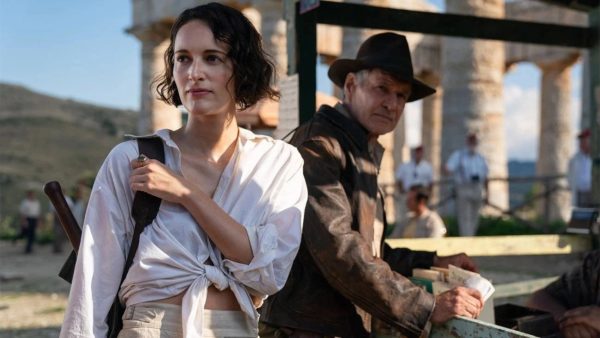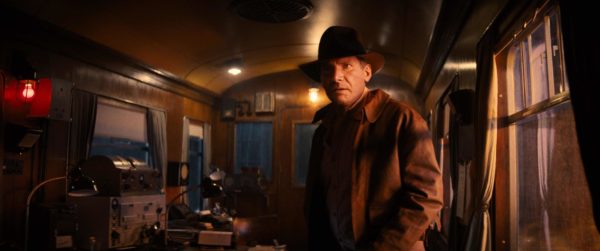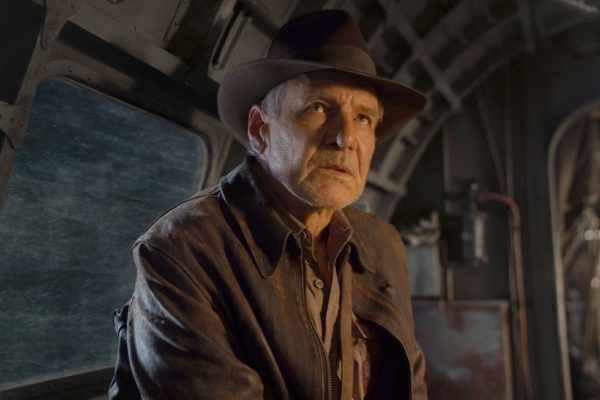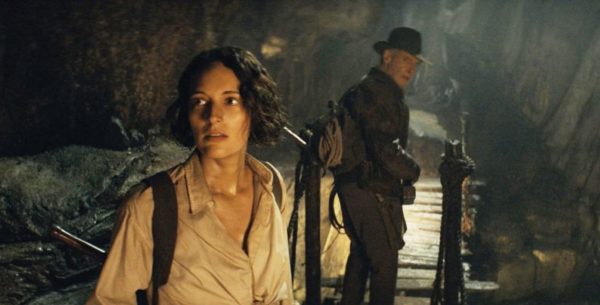
Indiana Jones and The Dial of Destiny makes a solid argument for giving the world’s most famous archeologist one last grand adventure.
Working from a script co-written by director James Mangold, Jez Butterworth, John-Henry Butterworth, and David Koepp, The Dial of Destiny proves that that there’s still movie magic to be found in Harrison Ford‘s sprawling action adventure series.
The purported final film in the long-running series opens in 1944 as a younger Indiana Jones (played by a mildly successful de-aged Ford) infiltrates a Nazi stronghold with his friend Basil Shaw (Toby Jones). They’re there to recover the spear that pierced Jesus, but the pair wind up setting their sight on Archimedes’ Dial of Destiny as the action moves from a castle to a train filled with Nazis.
The opening is a typical extended set piece that takes a few minutes to settle into familiar Indy territory. A comedic bit wherein Jones is nearly hung and/or crushed by a falling church bell feels like Mangold dressing up as Spielberg, but it’s not until Indy finds himself on the train, surrounded by Nazis, trying to rescue Basil, and recover half of the Dial that the film starts to embody the spirit of previous entries. As far as opening sequences go, this is solid, but perfunctory.
The cold open not only introduces the narrative’s ancient historical artefact, but the film’s antagonist as well. That would be Nazi scientist Jürgen Voller (Mads Mikkelsen), who has plans to use the time travel properties of the Dial to restore the party to game and glory.
Mikkelsen is a fantastic actor, but Voller is another in a long line of thankless villains the Danish actor has played in recent years. Mikkelsen has virtually nothing to do in the film and aside from his vaguely outlined plan for the Dial, his motivations are murky at best. Most of his screen time is strictly dedicated to following Indy around the globe, glowering and ordering his henchmen to continue their pursuit. It’s a role that could have been filled by any number of actors and hardly befitting Mikkelsen’s talents.

The Dial of Destiny really gets going when the action jumps ahead twenty-five years to touch base with Indy at a very different stage of his life. The fame archeologist is now on the cusp of retirement from Cambridge and he’s lost all of his joie de vivre. He’s now lecturing unenthusiastically, Marion (Karen Allen) is seeking a divorce, and there’s no sign of his son Mutt (played by Shia LaBoeuf in The Kingdom of the Crystal Skull and physically absent here).
Indy retires on the day of the Moon Landing, which coincides with a visit from his goddaughter Helena Shaw (Phoebe Waller-Bridge), Basil’s daughter. Indy hasn’t seen Helena in more than a decade, but it’s immediately clear that the woman is a grifter. She’s smart, charming, and most certainly not entirely forthcoming when she quizzes Indy about the whereabouts of the Dial.
Thankfully the ruse isn’t drawn out too long. Helena is being tailed by CIA agent Mason (Shaunette Renée Wilson) at the behest of Voller, now working as a Nasa scientist and given special privileges thanks to his role in the moon landing. Like Helena, it’s clear that the doctor is putting up a front, as evidenced by his brash and unpredictable second in command, Klaber (Boyd Holbrook), who tends to shoot first and ask for forgiveness later.
The next big set piece spreads the action across rooftops, through a parade, and even down into London’s Tube. While some of the CGI used for the crowds and Indy’s horse in this portion of the film is dodgy, overall it’s a solid and enjoyable sequence. From there the film moves to Tangier where Helena’s sidekick/protege Teddy (Ethann Isidore) is introduced amidst an extended car chase that falls somewhere between the mine chase in Temple of Doom and the Malta sequence in last year’s Jurassic World: Dominion. It’s all patently ridiculous, but still entertaining.

There’s more bonding between Indiana and Helena on a stopover to Sicily that establishes the film’s endgame, which simultaneously reveals more of Indy’s backstory.
If these quieter sequences work, it’s because of the natural chemistry between Ford and Waller-Bridge (with an assist from Isidore, who is channeling Ke Huy Quan’s Short Round hard). Helena won’t work for everyone, but in many regards she’s a younger, female version of Indiana, albeit stuck in Doom‘s “fame and glory” mindset.
Still, Waller-Bridge brings a welcome verve and energy to the proceedings, even if her roguish behaviour is predictably just disguising an inherently good person who can be counted on when push comes to shove.
These kinds of character tropes and formulaic narratives are expected when it comes to a Hollywood action franchise, but Indiana Jones and the Dial of Destiny really loses its way in its extended ending.
While Indy’s journey to rediscover his sense of purpose and place in the world results in a pitch perfect emotional send-off in the coda, the climax is groan-inducing and ridiculous. The franchise has never shied away from fantastical – or even supernatural – elements, but Voller’s plan feels out of place even among Indiana Jones‘ Arks, aliens, and grails.
It’s a disappointing finish for a film that was aspiring for a fantastic final send-off. While it works thematically to confront Indy’s sense of placelessness, Mangold et al.’s execution isn’t good. In fact, it makes the last twenty or so minutes of the film (before the epilogue) feel very, very dumb. 3.5/5

Other Observations:
- While it’s exciting to see Antonio Banderas turn up unexpectedly, it’s disappointing that his character Renaldo barely gets anything to do. The accompanying underwater sequence starts off menacing as Indy and Helena journey to the ocean floor to recover an artefact from a shipwreck, but the sequence feels abbreviated and the CGI is unconvincing.
- As much as I love briefly seeing John Rhys-Davies as Sallah, it’s a bit wild that in 2023 we’ve still got a British man playing Egyptian. Considering his appearance is little more than fan service, perhaps we just leave this character in Raiders of the Lost Ark and The Last Crusade?
- While so much of the finale doesn’t work, credit Ford and Waller-Bridge for selling the emotional nuance of the coda, which effectively puts Indiana to rest. The preceding 20 mins are among the worst that the film has to offer, but damn if this last sequence doesn’t stick the landing. It’s pitched perfectly.
Indiana Jones and the Dial of Destiny is now in theatres